 | | | Switch to: Europe, USA, New Zealand, Antarctica Credit: NOAA/Ovation  Planetary K-index Planetary K-index
Now: Kp= 2.33 quiet
24-hr max: Kp= 2.33 quiet
explanation | more data
Interplanetary Mag. Field
Btotal: 8.42 nT
Bz: -7.23 nT south
more data: ACE, DSCOVR
Updated: Today at 1146 UT  Coronal Holes: 20 Oct 23 Coronal Holes: 20 Oct 23 
There are no significant coronal holes on the Earthside of the sun. Credit: SDO/AIA  Noctilucent Clouds Noctilucent Clouds
The northern season for NLCs began on May 26th. The first clouds were detected inside the Arctic Circle by the NOAA 21 satellite. An instrument onboard NOAA 21 (OMPS LP) is able to detect NLCs (also known as "polar mesospheric clouds" or PMCs). For the rest of the season, daily maps from NOAA 21 will be presented here:
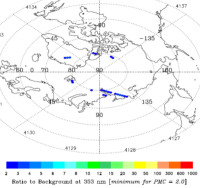
Updated: Aug. 29, 2023
Each dot is a detected cloud. As the season progresses, these dots will multiply in number and shift in hue from blue to red as the brightness of the clouds intensifies.
What happened to NASA's AIM spacecraft, which has been monitoring NLCs since 2007? Earlier this year, the spacecraft's battery failed. As a result AIM is offline, perhaps permanently. There may be some hope of a recovery as AIM's orbit precesses into full sunlight in 2024. Until then, we will maintain AIM's iconic "daily daisy," frozen at Feb. 28, 2023, as a show of thanks for years of service and hope for future daisies:  |  |  | Switch view:Ross Ice Shelf, Antarctic Peninsula, East Antarctica, Polar Updated Oct20  SPACE WEATHER
NOAA Forecasts | | Updated at: 2023 Oct 20 2200 UTC FLARE | 0-24 hr | 24-48 hr | CLASS M | 05 % | 05 % | CLASS X | 01 % | 01 % |  Geomagnetic Storms: Geomagnetic Storms:
Probabilities for significant disturbances in Earth's magnetic field are given for three activity levels: active, minor storm, severe storm Updated at: 2023 Oct 20 2200 UTC Mid-latitudes | 0-24 hr | 24-48 hr | ACTIVE | 30 % | 25 % | MINOR | 10 % | 10 % | SEVERE | 01 % | 01 % | High latitudes | 0-24 hr | 24-48 hr | ACTIVE | 15 % | 15 % | MINOR | 25 % | 25 % | SEVERE | 40 % | 35 % | | | |  | | | | | | | | | | | This is an AI Free Zone! Text created by ChatGPT and other Large Language Models is spreading rapidly across the Internet. It's well-written, artificial, frequently inaccurate. If you find a mistake on Spaceweather.com, rest assured it was made by a real human being. | | | MORE CMES ARE COMING: A pair of CMEs might graze Earth's magnetic field on Oct. 21st, say NOAA forecasters. They left the sun in quick succession on Oct. 17-18, neither one squarely targeting Earth. However, two glancing blows might be enough to cause a G1-class geomagnetic storm. Aurora alerts: SMS Text COSMIC RAY BALLOON PAYLOAD TRAPPED IN A GLACIER: Earlier this month, we reported on efforts to recover a lost Earth to Sky Calculus balloon payload. It was launched in October 2022--a full year ago--as part of our routine monitoring of atmospheric radiation. The launch went beautifully, but the landing did not. Blown off-course by winds in the stratosphere, the payload parachuted back to Earth near Echo Lake, a mile-wide pool of melted snow in California's Sierra Nevada at an altitude of 12,000 ft: 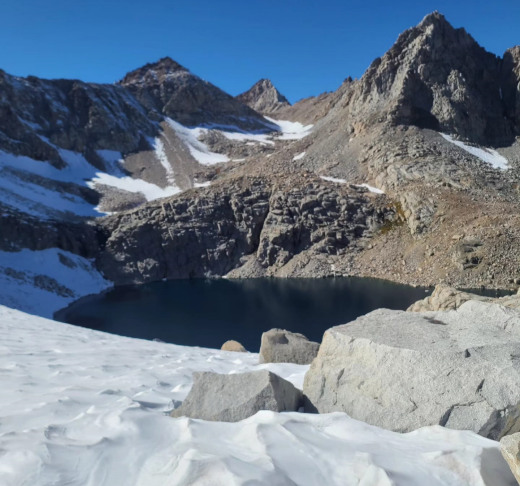
Echo Lake viewed from the landing site on Oct. 5, 2023
A year later it's still there. The payload touched down on a rocky slope almost a thousand feet above the lake. It was quickly buried by the Great Winter of 2023. at one point under as much as 30 feet of snow. Recovery teams led by Dr. Tony Phillips have visited Echo Lake five times (Oct. & Nov. 2022, August, Sept. and Oct. 2023) each time getting a little closer to the payload, but never recovering it. On Oct. 5th, we finally reached the landing site. What we found surprised us: 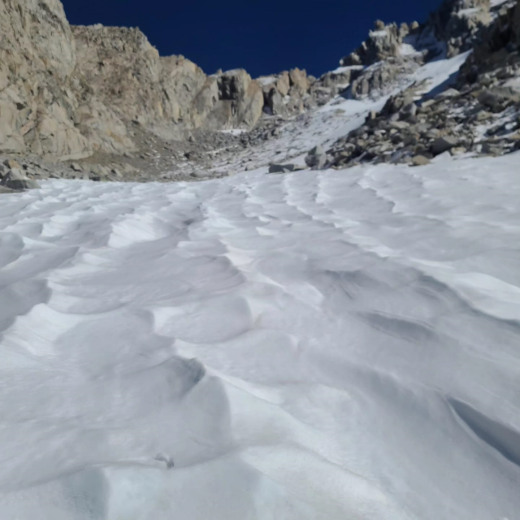
The payload is buried as much as 4 ft deep in this re-glaciating snow field.
The area around the landing site has experienced a remarkable "re-glaciation" event. Rocky terrain once dessicated by years of California drought is now a dense field of ice and snow impervious to summer heat. The payload is trapped in this almost-rock hard layer of snow. Our shovels bounced off the surface with no effect. We're going back this weekend, and this time we're taking a chainsaw. We hope to cut through the ice and find our cosmic ray sensors preserved in the frozen subsurface. If the payload is recovered, we will be able to finally stitch together a complete record of radiation data for the past year. Wish us luck, and stay tuned for updates! Realtime Space Weather Photo Gallery
Free: Spaceweather.com Newsletter HANDMADE ANNULAR SOLAR ECLIPSE PENDANT: This pendant has touched the shadow of the Moon. The students of Earth to Sky Calculus launched it to the stratosphere on Oct. 14, 2023, during the annular solar eclipse. The handmade pendant was 78,500 feet high when the Moon's shadow arrived and wrapped it in a cool twilight-like darkness: 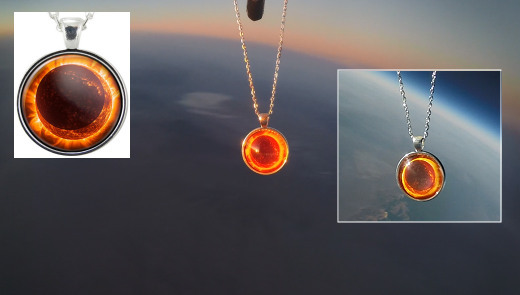
You can have it for $129.95. The pendant left Earth from Nevada's Valley of the Moon, a remote area filled with the scent of sage and herds of wild horses. Indeed, no fewer than three mustang families approached the launch team during the eclipse to see what was going on. It was a magical experience. The students are selling space pendants to pay the helium bill for their cosmic ray ballooning program. Each one comes with a greeting card showing the jewelry in flight and telling the story of its trip to the stratosphere and back again. Far Out Gifts: Earth to Sky Store
All sales support hands-on STEM education
Realtime Space Weather Photo Gallery
Free: Spaceweather.com Newsletter
Realtime Aurora Photo Gallery
Free: Spaceweather.com Newsletter
Realtime Comet Photo Gallery
Free: Spaceweather.com Newsletter Every night, a network of NASA all-sky cameras scans the skies above the United States for meteoritic fireballs. Automated software maintained by NASA's Meteoroid Environment Office calculates their orbits, velocity, penetration depth in Earth's atmosphere and many other characteristics. Daily results are presented here on Spaceweather.com. On Oct 20, 2023, the network reported 20 fireballs.
(15 sporadics, 2 Orionids, 2 Southern Taurids, 1 Leonis Minorid) 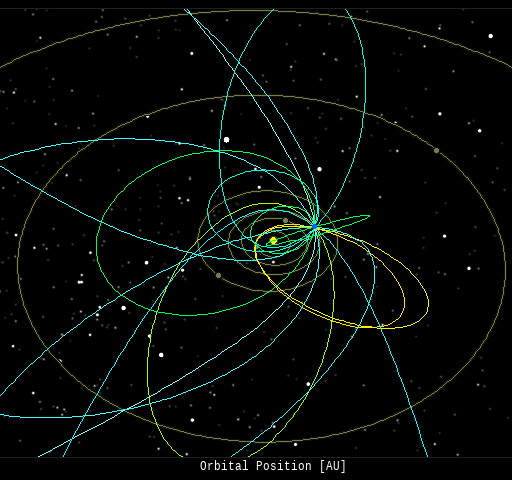 In this diagram of the inner solar system, all of the fireball orbits intersect at a single point--Earth. The orbits are color-coded by velocity, from slow (red) to fast (blue). [Larger image] [movies] Potentially Hazardous Asteroids ( PHAs) are space rocks larger than approximately 100m that can come closer to Earth than 0.05 AU. None of the known PHAs is on a collision course with our planet, although astronomers are finding new ones all the time. On October 20, 2023 there were 2349 potentially hazardous asteroids.
 | Recent & Upcoming Earth-asteroid encounters: | Asteroid | Date(UT) | Miss Distance | Velocity (km/s) | Diameter (m) | | 2023 US2 | 2023-Oct-15 | 9.2 LD | 11.8 | 15 | | 2023 TC7 | 2023-Oct-15 | 1.7 LD | 6.8 | 15 | | 2023 TZ6 | 2023-Oct-15 | 11.1 LD | 12.5 | 19 | | 2011 GA | 2023-Oct-15 | 6.8 LD | 16.6 | 230 | | 2023 UY1 | 2023-Oct-15 | 10.8 LD | 6.2 | 13 | | 2023 UX1 | 2023-Oct-15 | 6.6 LD | 20.7 | 23 | | 2023 UB | 2023-Oct-15 | 0.2 LD | 15.6 | 4 | | 2023 TZ8 | 2023-Oct-15 | 11.1 LD | 9.4 | 17 | | 2007 SQ6 | 2023-Oct-15 | 19.4 LD | 6.5 | 128 | | 2023 US | 2023-Oct-16 | 10.9 LD | 8.6 | 23 | | 2023 TA4 | 2023-Oct-16 | 7.3 LD | 4.1 | 11 | | 2023 TR15 | 2023-Oct-16 | 3.4 LD | 8.8 | 9 | | 2023 UR2 | 2023-Oct-16 | 3.3 LD | 8.2 | 19 | | 2019 UZ3 | 2023-Oct-16 | 9.6 LD | 8.3 | 14 | | 2023 TT8 | 2023-Oct-16 | 5.8 LD | 7.9 | 17 | | 2023 TN15 | 2023-Oct-16 | 12.4 LD | 3.9 | 12 | | 1998 HH49 | 2023-Oct-17 | 3.1 LD | 14.8 | 193 | | 2023 UU1 | 2023-Oct-17 | 1.4 LD | 9.1 | 12 | | 2023 TF8 | 2023-Oct-17 | 5.5 LD | 20.1 | 15 | | 2023 TT15 | 2023-Oct-17 | 6.2 LD | 6.4 | 9 | | 2023 TH12 | 2023-Oct-17 | 7.8 LD | 8.3 | 23 | | 2023 TT16 | 2023-Oct-17 | 1.4 LD | 20.2 | 9 | | 2023 TT36 | 2023-Oct-18 | 11.7 LD | 7.1 | 19 | | 2023 UJ1 | 2023-Oct-18 | 13.4 LD | 14.7 | 22 | | 2022 UO10 | 2023-Oct-19 | 7.8 LD | 9.8 | 16 | | 2023 TH4 | 2023-Oct-19 | 5.5 LD | 5.4 | 14 | | 2023 TM14 | 2023-Oct-19 | 8.3 LD | 7 | 17 | | 2023 TY19 | 2023-Oct-19 | 14.6 LD | 9.2 | 18 | | 2023 TP7 | 2023-Oct-19 | 8 LD | 11.7 | 27 | | 2023 UP | 2023-Oct-19 | 2.7 LD | 14.2 | 9 | | 2023 UW1 | 2023-Oct-19 | 2.1 LD | 7.4 | 16 | | 2020 UR | 2023-Oct-20 | 5.8 LD | 12.9 | 9 | | 2023 TK15 | 2023-Oct-20 | 1 LD | 22 | 23 | | 2023 UH | 2023-Oct-20 | 6.8 LD | 11.1 | 21 | | 2023 UV1 | 2023-Oct-21 | 2.9 LD | 9.7 | 19 | | 2023 UR1 | 2023-Oct-21 | 2.2 LD | 8.2 | 37 | | 2023 UW | 2023-Oct-21 | 4.2 LD | 6 | 9 | | 2023 UN | 2023-Oct-21 | 1.3 LD | 11.2 | 24 | | 2023 UL2 | 2023-Oct-21 | 14.6 LD | 15.7 | 50 | | 2023 UH1 | 2023-Oct-21 | 9.9 LD | 5.1 | 14 | | 2023 UP2 | 2023-Oct-21 | 3.7 LD | 8.7 | 17 | | 2023 UG1 | 2023-Oct-22 | 4.4 LD | 2.9 | 11 | | 2023 TW4 | 2023-Oct-22 | 6.4 LD | 10.5 | 26 | | 2023 TX2 | 2023-Oct-22 | 13.2 LD | 7.5 | 30 | | 2023 TW26 | 2023-Oct-22 | 2.3 LD | 5.6 | 7 | | 2023 UZ | 2023-Oct-22 | 2.5 LD | 13.1 | 12 | | 2023 TP16 | 2023-Oct-23 | 3.8 LD | 1.5 | 4 | | 2023 TV4 | 2023-Oct-23 | 5.1 LD | 5 | 29 | | 2023 TC6 | 2023-Oct-23 | 13.4 LD | 8.5 | 35 | | 2020 FM6 | 2023-Oct-23 | 15.5 LD | 15.9 | 149 | | 2023 TX8 | 2023-Oct-24 | 3.3 LD | 5.6 | 18 | | 2019 HH4 | 2023-Oct-24 | 13.3 LD | 20 | 381 | | 2023 TE6 | 2023-Oct-24 | 17 LD | 4.2 | 18 | | 2023 RA4 | 2023-Oct-24 | 8.4 LD | 3.9 | 47 | | 2023 SO11 | 2023-Oct-25 | 3.3 LD | 2.5 | 16 | | 2023 TG14 | 2023-Oct-26 | 4.2 LD | 6.7 | 24 | | 2023 UJ2 | 2023-Oct-26 | 11.8 LD | 3.2 | 47 | | 2023 TR7 | 2023-Oct-26 | 19.3 LD | 11.4 | 30 | | 2021 SZ4 | 2023-Oct-26 | 14 LD | 30 | 289 | | 302169 | 2023-Oct-26 | 12.7 LD | 25.7 | 374 | | 2023 UA2 | 2023-Oct-29 | 12.9 LD | 9.2 | 14 | | 525229 | 2023-Oct-30 | 10.6 LD | 17.4 | 200 | | 2023 TW6 | 2023-Oct-31 | 19.2 LD | 24.4 | 88 | | 2013 UV3 | 2023-Nov-01 | 14.7 LD | 15.4 | 15 | | 2016 WY | 2023-Nov-02 | 9.1 LD | 3.9 | 5 | | 363505 | 2023-Nov-02 | 13.7 LD | 8 | 709 | | 2022 JF | 2023-Nov-03 | 15.2 LD | 17.2 | 39 | | 2023 QP8 | 2023-Nov-03 | 17.1 LD | 8.8 | 180 | | 2016 VW2 | 2023-Nov-03 | 10.1 LD | 8.1 | 20 | | 2019 UH7 | 2023-Nov-04 | 9.9 LD | 5.9 | 11 | | 2023 TL31 | 2023-Nov-04 | 8.2 LD | 9.2 | 28 | | 2023 TO15 | 2023-Nov-06 | 15.2 LD | 11.2 | 48 | | 2023 TD14 | 2023-Nov-08 | 9.3 LD | 6.3 | 24 | | 2023 TZ2 | 2023-Nov-12 | 19 LD | 2.8 | 24 | | 2014 BA3 | 2023-Nov-13 | 15.7 LD | 2.7 | 8 | | 2023 UO | 2023-Nov-15 | 6.4 LD | 6.8 | 36 | | 2021 TN3 | 2023-Nov-15 | 17 LD | 6.3 | 31 | | 2019 VL5 | 2023-Nov-16 | 8.5 LD | 8.2 | 24 | | 2019 LB1 | 2023-Nov-18 | 15.8 LD | 4.2 | 14 | | 2016 DK1 | 2023-Nov-19 | 5.3 LD | 6.8 | 12 | | 2022 VR1 | 2023-Nov-19 | 8.1 LD | 6.1 | 39 | | 2019 UT6 | 2023-Nov-24 | 9 LD | 13.2 | 141 | | 2019 CZ2 | 2023-Nov-25 | 2.8 LD | 5.8 | 44 | | 2013 UB3 | 2023-Nov-27 | 18.5 LD | 5.4 | 25 | | 1998 WB2 | 2023-Dec-03 | 11 LD | 14.2 | 151 | | 2013 VX4 | 2023-Dec-04 | 5.1 LD | 6.6 | 60 | | 2023 TB27 | 2023-Dec-06 | 17.1 LD | 4.3 | 46 | | 139622 | 2023-Dec-06 | 14.4 LD | 6.7 | 719 | | 2020 HX3 | 2023-Dec-10 | 9.8 LD | 15.7 | 13 | | 2010 XF3 | 2023-Dec-11 | 19.4 LD | 4 | 46 | Notes: LD means "Lunar Distance." 1 LD = 384,401 km, the distance between Earth and the Moon. 1 LD also equals 0.00256 AU. | | Cosmic Rays in the Atmosphere | SPACE WEATHER BALLOON DATA: Almost once a week, Spaceweather.com and the students of Earth to Sky Calculus fly space weather balloons to the stratosphere over California. These balloons are equipped with sensors that detect secondary cosmic rays, a form of radiation from space that can penetrate all the way down to Earth's surface. Our monitoring program has been underway without interruption for 7 years, resulting in a unique dataset of in situ atmospheric measurements. Latest results (July 2022): Atmospheric radiation is decreasing in 2022. Our latest measurements in July 2022 registered a 6-year low: 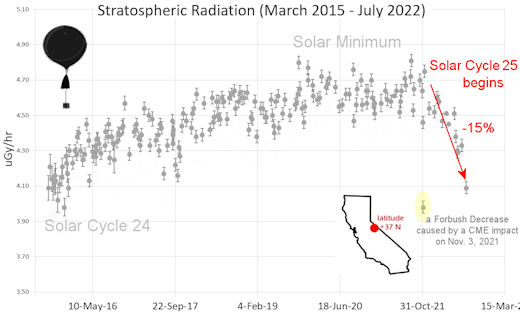
What's going on? Ironically, the radiation drop is caused by increasing solar activity. Solar Cycle 25 has roared to life faster than forecasters expected. The sun's strengthening and increasingly tangled magnetic field repels cosmic rays from deep space. In addition, solar coronal mass ejections (CMEs) sweep aside cosmic rays, causing sharp reductions called "Forbush Decreases." The two effects blend together to bring daily radiation levels down. .Who cares? Cosmic rays are a surprisingly "down to Earth" form of space weather. They can alter the chemistry of the atmosphere, trigger lightning, and penetrate commercial airplanes. According to a study from the Harvard T.H. Chan school of public health, crews of aircraft have higher rates of cancer than the general population. The researchers listed cosmic rays, irregular sleep habits, and chemical contaminants as leading risk factors. A number of controversial studies (#1, #2, #3, #4) go even further, linking cosmic rays with cardiac arrhythmias and sudden cardiac death. Technical notes: The radiation sensors onboard our helium balloons detect X-rays and gamma-rays in the energy range 10 keV to 20 MeV. These energies span the range of medical X-ray machines and airport security scanners. Data points in the graph labeled "Stratospheric Radiation" correspond to the peak of the Regener-Pfotzer maximum, which lies about 67,000 feet above central California. When cosmic rays crash into Earth's atmosphere, they produce a spray of secondary particles that is most intense at the entrance to the stratosphere. Physicists Eric Regener and Georg Pfotzer discovered the maximum using balloons in the 1930s and it is what we are measuring today. | | The official U.S. government space weather bureau | | | The first place to look for information about sundogs, pillars, rainbows and related phenomena. | | | Researchers call it a "Hubble for the sun." SDO is the most advanced solar observatory ever. | | | 3D views of the sun from NASA's Solar and Terrestrial Relations Observatory | | | Realtime and archival images of the Sun from SOHO. | | | information about sunspots based on the latest NOAA/USAF Active Region Summary | | | current counts of failed and deployed Starlink satellites from Jonathan's Space Page | | | Authoritative predictions of space junk and satellite re-entries | | | from the NOAA Space Environment Center | | | fun to read, but should be taken with a grain of salt! Forecasts looking ahead more than a few days are often wrong. | | | from the NOAA Space Environment Center | | | the underlying science of space weather |  | When looking for casinos to play online when the weather is bad, you can try casino online trucchi for Italian games. If you are not from Finland you can try the Swedish page Svenska casino online to find suitable games, check out svenskacasinoonline.net. Always check your local laws before playing with real money. |  | BestCSGOGambling is the best site for everything related to CSGO gambling on the web | | | These links help Spaceweather.com stay online. Thank you to our supporters! | | | | | | | | |  | |  |   | ©2021 Spaceweather.com. All rights reserved. This site is penned daily by Dr. Tony Phillips. | |

